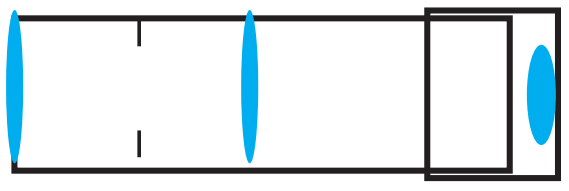Practical Exercise 3: ENHANCED KEPLER-TYPE TELESCOPE
1. Glue two identical lenses, medium or large, with a suitable paper tube at a distance of 0.8 f. If the focal length of the medium lens is 14 cm, prepare the objective lens in a way that the lenses are 11.2 cm away.
2. In the centre of the objective lens (exactly between the lenses), glue a diaphragm whose diameter is one-tenth smaller than the diameter of the lenses used. That means, for medium lenses with a diameter of 6.5 cm, in the centre of the lens glue a circle cut out from hard paper with a hole and diameter of about 5.9 cm.

Figure 7: Scheme of an enhanced telescope
3. With the created objective lens, replace one lens objective from Practical Exercise 1.
4. With the telescope, you can easily observe craters on the Moon, the Andromeda Galaxy, the Orion Nebula, however without much detail of the planet (for that you need a real telescope).


